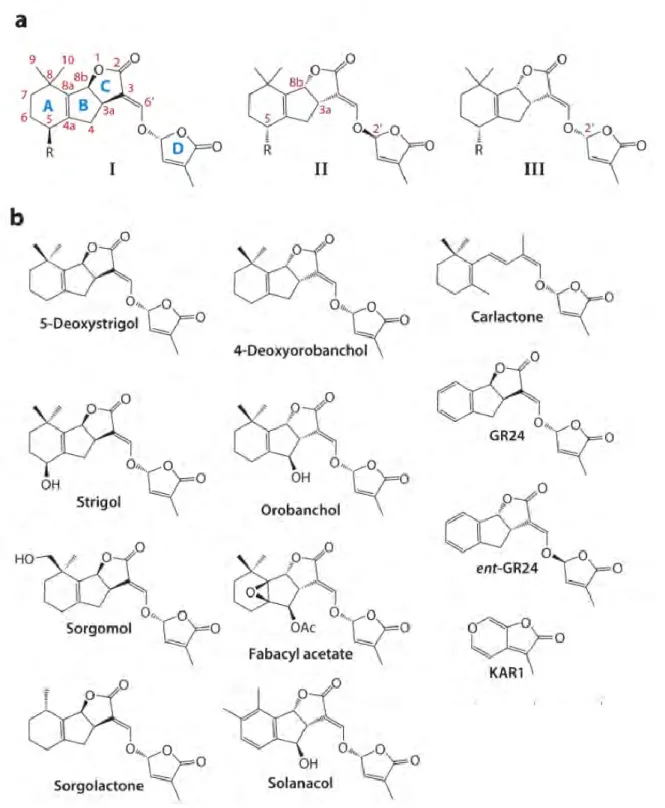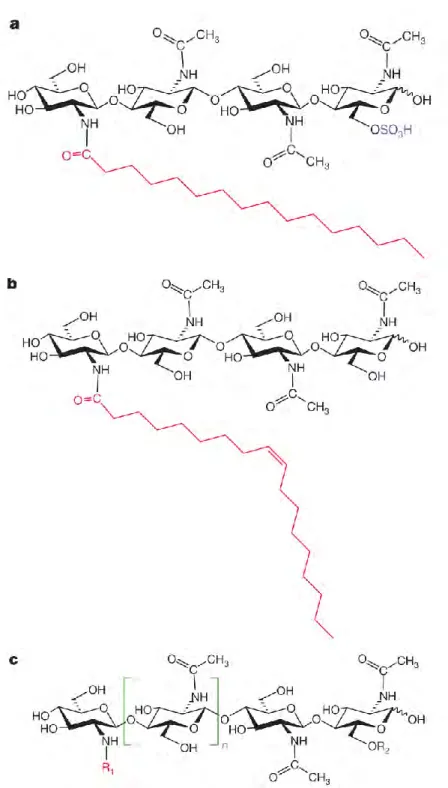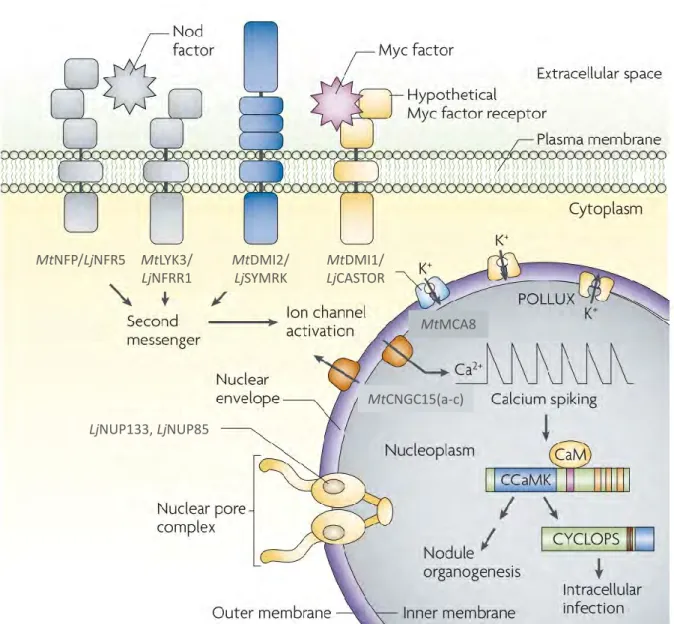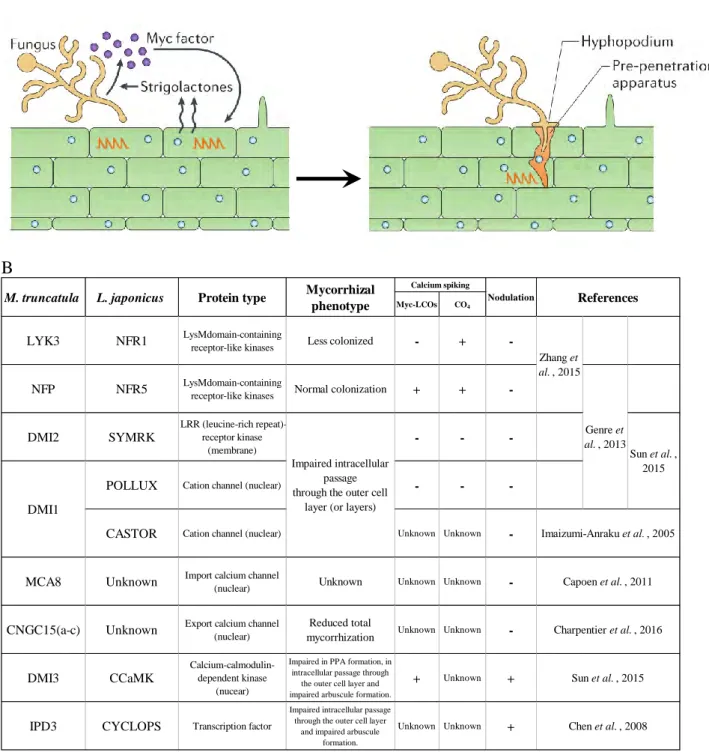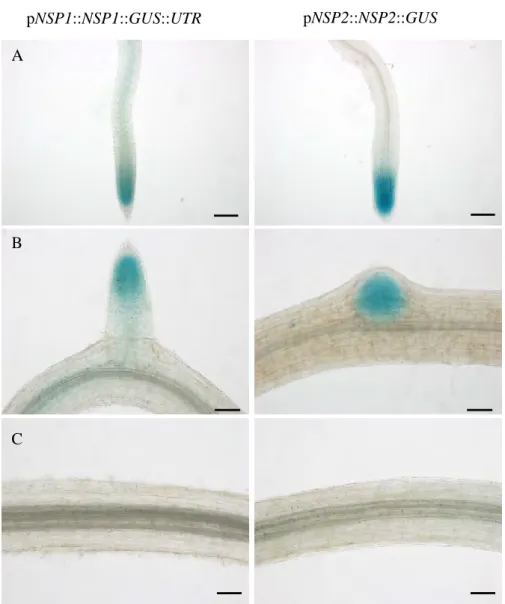Une pensée toute particulière pour quelqu'un qui nous a quitté trop tôt (exil fiscal en Suisse malheureusement), mais qui m'a permis de prendre pied dans le labo à mon arrivée. Cela m'a permis dans de nombreux cas de faire un véritable exercice de vulgarisation de mon sujet.
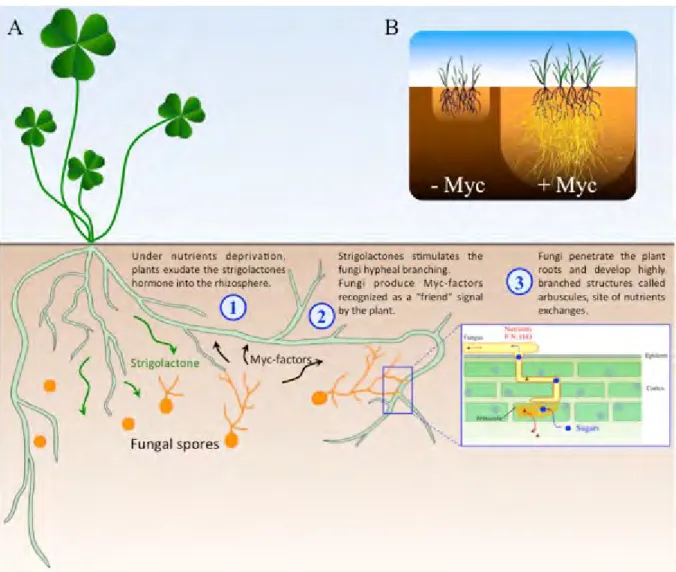
Beneficial interactions start with an educated dialogue
Rhizospherical role of strigolactones
Myc-LCOs have been shown to stimulate the mycorrhizal process, including in nonlegumes (Maillet et al., 2011). This hyphopodium formation has been shown to be negatively controlled by phosphate (Balzergue et al., 2011).
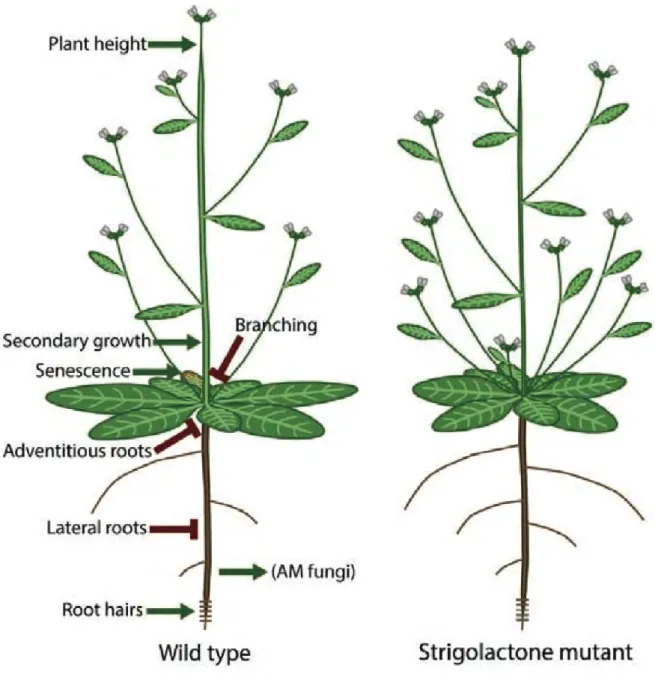
Arbuscular mycorrhizal symbiosis, a highly regulated partnership
The concept of Autoregulation
The presence of AM-colonized roots in one compartment leads, in the other compartment, to a strong decrease in root susceptibility to further colonization events (Vierheilig et al., 2000; Vierheilig, 2004). This lower susceptibility of root colonization also appears to be highly dependent on the plant phosphate status since supplementing one compartment with phosphate leads to the suppression of colonization in the second compartment (Balzergue et al., 2011).
Strigolactone regulation
Nevertheless, disruption of ABA biosynthesis has been shown to negatively affect SL production (Matusova, 2005; López-Ráez et al., 2010). 29 NSP1 may not be crucial for later stages of colonization and arbuscule morphogenesis (Delaux et al., 2013).
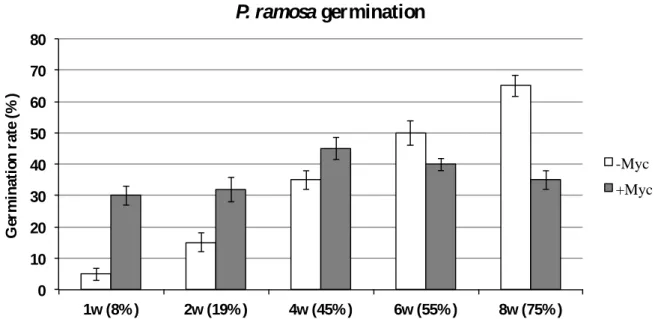
Other regulations
Biosynthesis and metabolism of 31 in GA has been shown to be expressed in arbuscule-containing cells (Takeda et al., 2015). Consistent with these studies, a decrease in AM colonization (both in terms of colonization frequency and arbuscule abundance) was observed in the tomato mutant (procera) with a GA constitutive response ( Martín-Rodríguez et al., 2015 ).
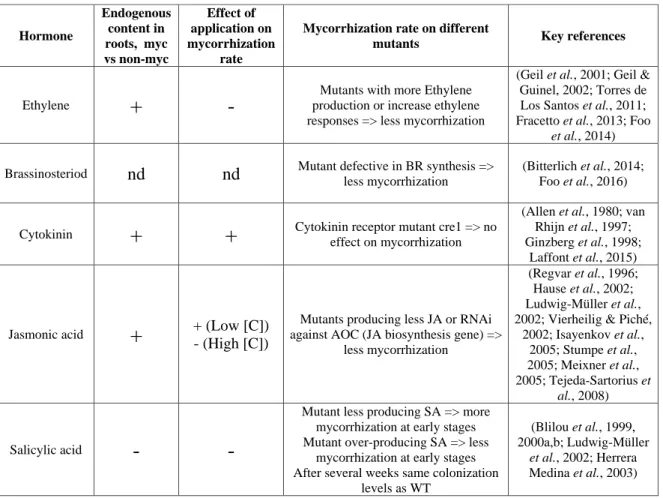
Doctoral work main goals
Results
NSP1 directly activates the expression of D27 and MAX1
During the first steps of this work, we used a construct containing 3 kb of the promoter region of D27 and MAX1 fused to the GUS sequence. In contrast, expression of NSP1, alone or together with NSP2, was sufficient to drive D27 and MAX1 expression (Fig. 3A).
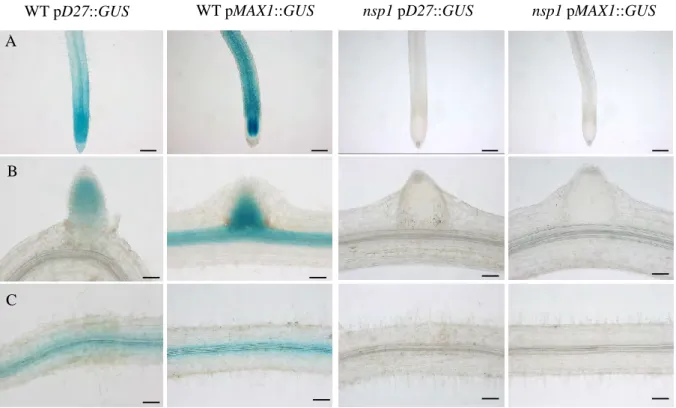
Expression analyses of NSP1, NSP2, D27 and MAX1 during mycorrhization reveal distinct expression patterns
To know whether NSP1 directly interacts with D27 and MAX1 promoters, we performed Chromatin Immunoprecipitation (ChIP) of NSP1 displaying an HA tag (Fig. 3B). To test this hypothesis, we analyzed the expression of D27 and MAX1 in mycorrhizal nsp1 mutant plants, and we observed the same pattern as in the wild-type plants: a strong expression of D27 and MAX1 in arbuscule-containing tissues (Fig. 6 B).
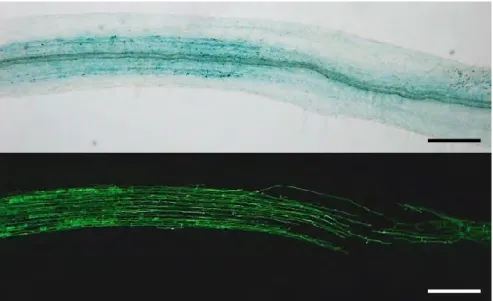
NSP1 and NSP2 play different roles during mycorrhization
In all conditions, both the D27 and MAX1 promoters appear to be expressed in the arbuscule-containing tissues. We next performed the same phenotyping analysis of the nsp2 plants and, in contrast to what we observed in the nsp1 mutant, hyphae propagation within the roots of nsp2 was reduced compared to the wild type (Fig. 8B).
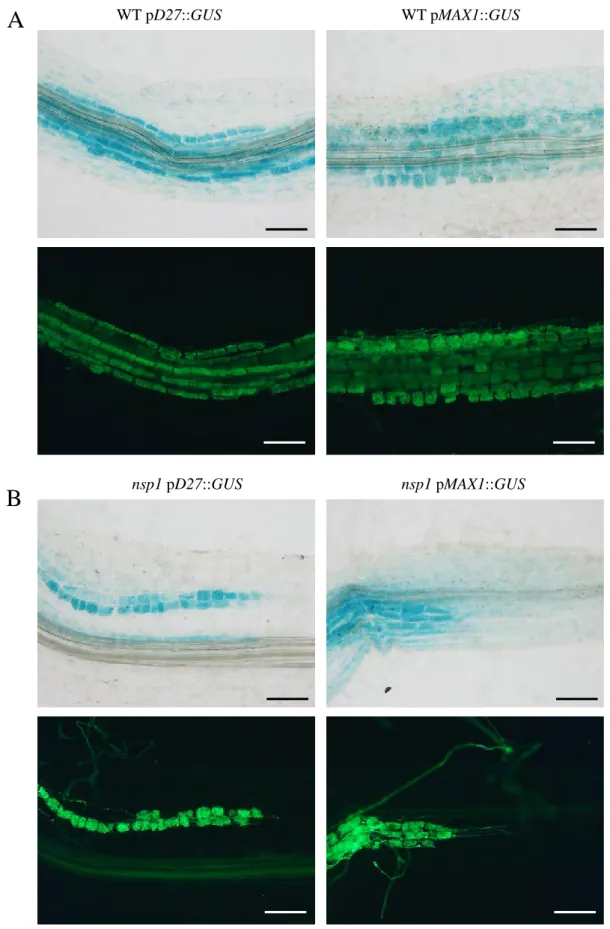
Discussion
Consistent with this, NSP2 has been shown to interact with several other GRAS TFs involved in the mycorrhization process, such as RAD1 or TF80 (Park et al., 2015). Finally, NSP2 expression is under the control of the miR171h which is also expressed. in the arbuscule-containing regions. However, as shown by Liu et al., 2011, it is highly likely that NSP2 is involved in the regulation of D27 and MAX1 expression at least in asymbiotic conditions.
Finally, the question of the role of SLs in planta, after the entry of the fungus into the root, is still open. The GUS expression pattern shows highly specific expression of NSP1 in meristematic zones I and II of the nodule.
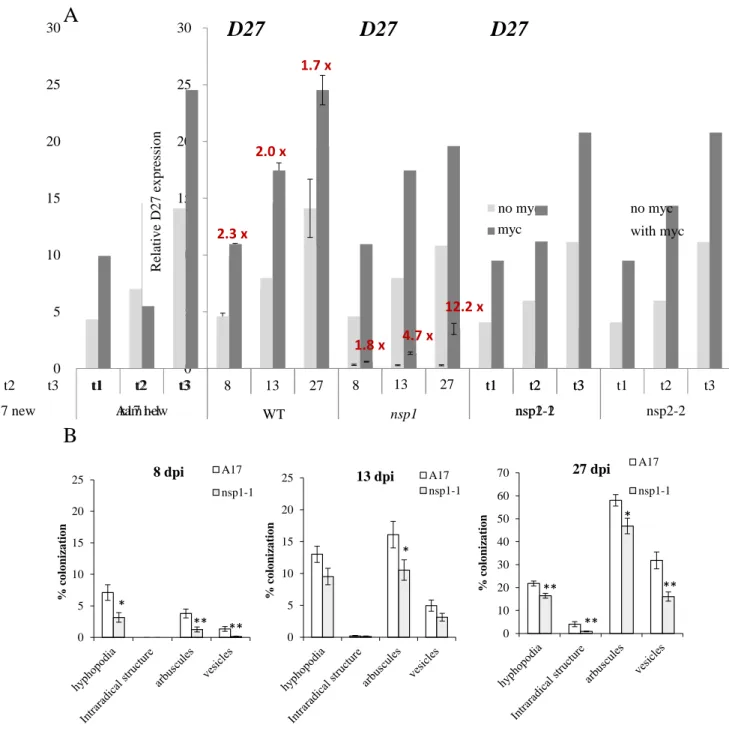
Material and Methods
- Biological material
- Tobacco agroinfiltration and GUS quantification
- Strigolactone treatments and Myc-LCO treatment
- Chromatin Immuno-Precipitation
- Mycorrhizal phenotyping and fungus staining
- Statistical analyses
A modified pCAMBIA2200 binary vector was used with the Golden Gate strategy for cloning (Engler et al., 2008). As described by Boisson-Dernier et al. 2001), two days before transformation, Agrobacterium rhizogenes ARqua1 (Quandt, 1993) cultures containing the constructs of interest were grown on solid LB supplemented with the antibiotic of selection kanamycin (25 μg/ml) at 28°C. -LCO was described by Maillet et al. 2011) and provided by Eric Samain, Sébastien Fort and Sylvain Cottaz (CERMAV, Grenoble, France).
GoldGate MtNSP1 prom+gen Fw BsaI AAAGGTCTCAAAATATGCCTTTATCATTTTTGGGG GoldGate MtNSP1 prom+gen Rv BsaI AAAGGTCTCACCATTTCTGGTTGTTTATCCAGTTCC GoldGate MtNSP1 3'UTR Fw BsaI AAAGGTCTCCTTCGTTCGAGCTCAACATTGACAGCA GoldGate M tNSP1 3'UTR Rv BsaI AAAGGTCTCCCGTACCTCCTCCTTATACTTTCTTG GoldGate MtNSP2 prom+gen Fw BsaI AAAGGTCTCCAAATTGTAGACTTCAATAAACTAAT GoldGate MtNSP2 prom+gen Rv BsaI AAAGGTCTCTCCATTAAATCAGAATCTGAAGAAGAAC GoldGate MtNSP2 3'UTR Fw BsaI AAAGGTCTCCTTCGGATGCTGATTAATTAAGTGCTAA GoldGate MtNSP2 3'UTR Rv BsaI AAAGGTCTCCCGTAGTCCTTAAACCTACACTTTAG GoldGate MtD27 prom 3kb Fw Bsal AAAGGTCTCCAAATCAGGTAAACCCCCCTTTTC GoldGate MtD27 prom 1kb Fw B saI AAAGGTCTCCAAATAGATTCACACATTATTTACG GoldGate MtD27 prom Rv BsaI AAAGGTCTCTCCATTTGTGAGTAGTTATTGATTTTCAT GoldGate MtMAX1 prom 3kb Fw BsaI AAAGGTCTCAAAATTTTAGAAAAGTTGATCCGGATC GoldGate MtMAX1 prom 1kb Fw BsaI AAAGGTCTCAAAATGA CCTCAAAAAACCATTTTTTTTA GoldGate MtMAX1 prom Rv BsaI AAAGGTCTCACCATTGCAAATTCAATAGAGTAGTAGA GoldGate MtNSP2 prom Rv BsaI AAAGGTCTCTCCATGGTATAATTAAGTTAGGT GoldGate MtNSP1 prom Rv BsaI AAAGGTCTCTCCATTGTAATGAAAAAACAGAAAAAA GoldGate MtNSP2 gen+UTR Fw BsaI AAAGGTCTCCAATGG ATTTGATGGACATGGATG GoldGate MtD27 RNAi sens Fw za 35S prom BsaI AAAGGTCTCCTAGCATGGATTCAAAGATGATTGCAC GoldGate MtD27 RNAi sens Fw za vapy prom BsaI AAAGGTCTCCGTGTATGGATTCAAAGATGATTGCAC GoldGate Prom vapy golden Fw BsaI AAAGGTCTCcAAATCGGTAAGGGTTACATAAAAGAT GoldGate MtD27 RNAi sens Rv BsaI AAAGGTCTCCGCGTCTGTTGCTGCTTGAACACTTT GoldGate MtD27 RNAi antisens Fw BsaI AAAGGTCTCCATTACTGTTGCTGCTTGAACACCTTT GoldGate MtD27 RNAi antisens Rv BsaI AAAG GTCTCCCGTAATGGATTCAAAGATGATTGCAC. Listi tobaka so bili transformirani, kot je opisano zgoraj, da bi v tem heterolognem sistemu izrazili konstrukte MtpD27 ali MtpMAX1::GUS z ali brez so-ekspresije konstrukta 35S::MtNSP1(HAtag).
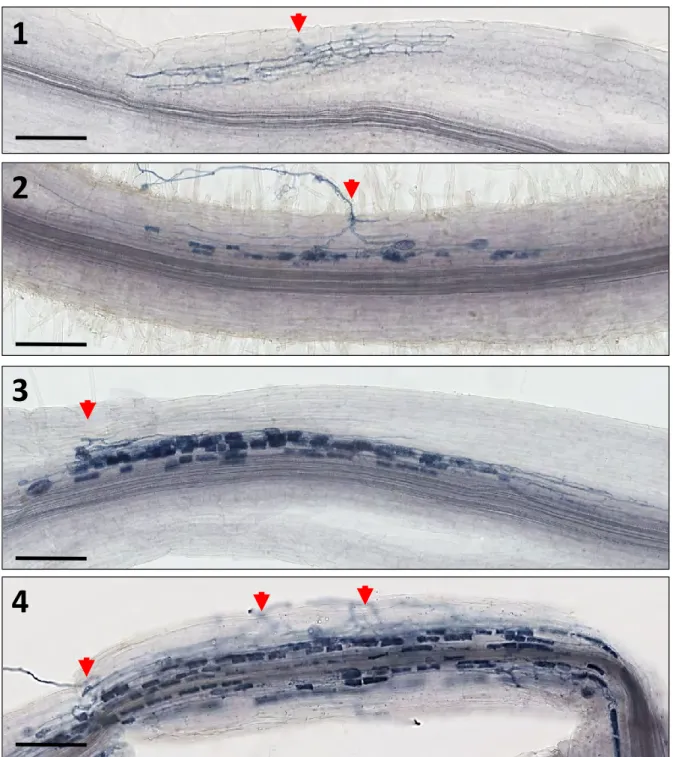
DCL1
DCL1Pri miRNA
Introduction
In recent years, a very active research has gradually revealed the numerous, previously unexpected, regulatory functions of non-coding RNAs (ncRNAs) (Amor et al., 2009; Li & Zhang, 2016; Gulyaeva & Kushlinskiy, 2016). This reduces the pool of active miRNAs and therefore reduces overall miRNA activity toward its real target PHO2 (Franco-Zorilla et al., 2007) (Fig. 2). This natural molecular mechanism also exists in animals (termed miR sponges, Ebert et al., 2007) and is believed to participate in miRNA homeostasis (Seitz, 2009).
Furthermore, in transgenic roots where NSP2 is mutated to modify the target site of miR171h, a much higher fungal colonization is observed, even in the root tips (Lauressergues et al., 2012). Thus, it has been suggested that miR171h and NSP2 are important molecular players in the spatial regulation of AM fungal colonization (Lauressergues et al., 2012).
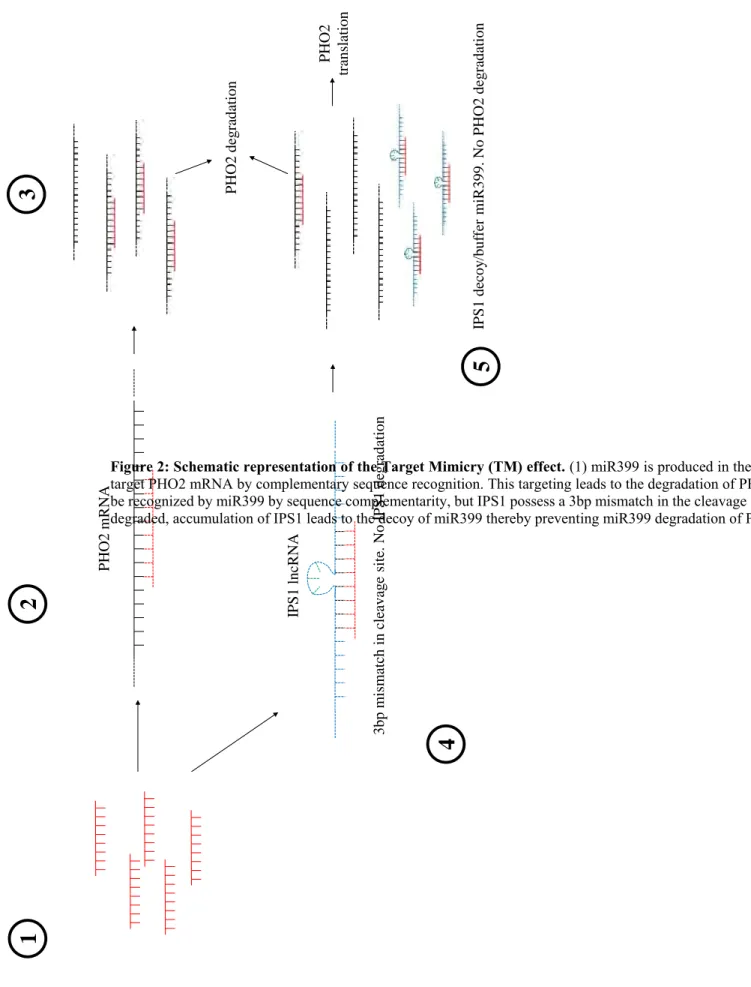
Results
- MtNSP1 is able to act as a target mimic in tobacco leaves
- Mt-NSP1, Mt-NSP2, and Mt-miR171h expression are colocalized during mycorrhization
- Mt-NSP1 plays a role as a target mimic during mycorrhization
- Prediction of potential new coding target mimics (cTMs)
We also checked that the mutation introduced in the NSP1 sequence did not affect its expression (Fig. S1). Using GUS promoter constructs (and in situ hybridization for miR171h), it was previously reported that miR171h and NSP2 are expressed in arbuscule-containing cells (Hofferek et al., 2014). When we analyzed the expression pattern of the NSP1 promoter fused to the GUS sequence, we observed that NSP1 mRNA was expressed in arbuscule-containing tissues (Figure 5 A).
Altogether, these data indicate that the interaction between miR171h and the transcripts of NSP1 and NSP2 is physically possible since these molecules are present in the same root tissues. The expression pattern of pNSP2::NSP2::GUS constrcutc appears to be localized in the fungus-containing structures.
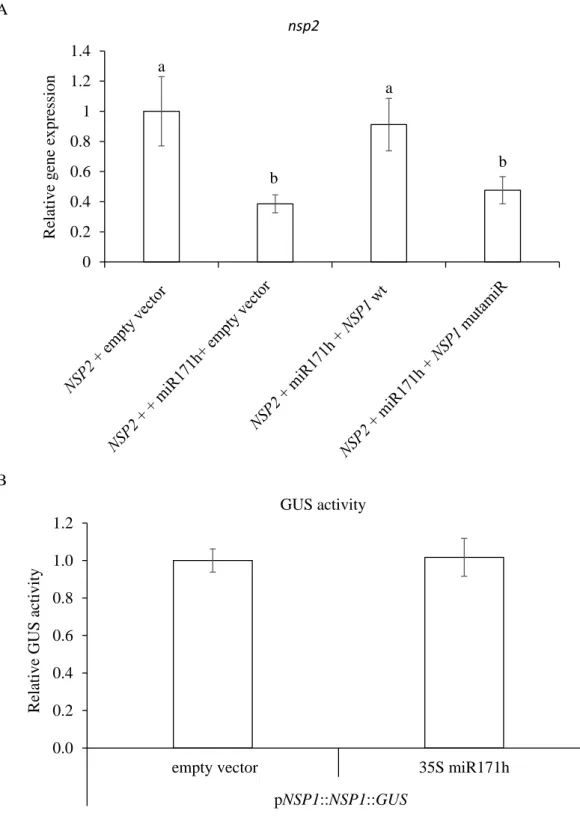
Discussion
First, we look for mRNA coding sequences that have a gap of 3 nucleotides at the critical position of 10-11 microRNAs. This complex regulation must also play a role in root development, as miR171h was found to be expressed in root meristematic and elongation zones such as NSP1 and NSP2 (Untergasser et al., 2012) (Chapter 1. As miR171h is expressed at low levels along the root, and pNSP1::GUS expression appears to be localized to the central whorl, where NSP2 is also expressed (Fig. S2).
The cTMs would be especially efficient to capture escaping, less concentrated miRNAs in the neighboring cells. The activity of miRNAs to be restricted in the appropriate cells would occur where their concentration is highest, i.e.
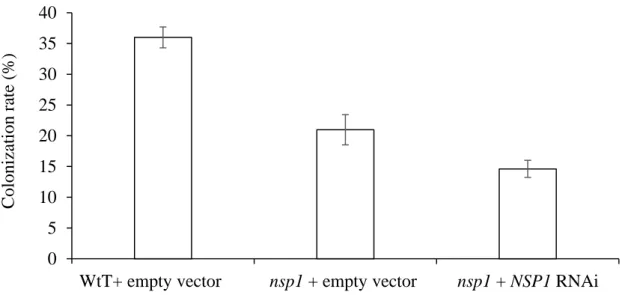
Materials and methods
- In-silico TMs prediction
- Biological material
- Plasmid construction
- Tobacco agroinfiltration and GUS assays
- Hairy root transformation
- Mycorrhizal phenotyping and fungus staining
- Statistical analyses
We have previously shown by qRT-PCR that Sl-IAA27 expression is globally up-regulated in mycorrhizal roots of tomato (Bassa et al., 2013). To obtain additional information about Sl-IAA27 expression in roots of mycorrhizal plants, we used transgenic pSL-IAA27::GUS tomato lines ( Bassa et al., 2012 ). Total root colonization was greatly reduced in the RNAi Sl-IAA27 lines (average of the three lines) compared to the wild type (Fig. 2a).
We found that the expression of Sl-D27 and Sl-MAX1 was also down-regulated in the three Sl-IAA27 RNAi tomato lines compared with control plants (Fig. 3a). We did not detect significant changes in Sl-IAA9 expression in roots of Sl-IAA27 silenced lines.
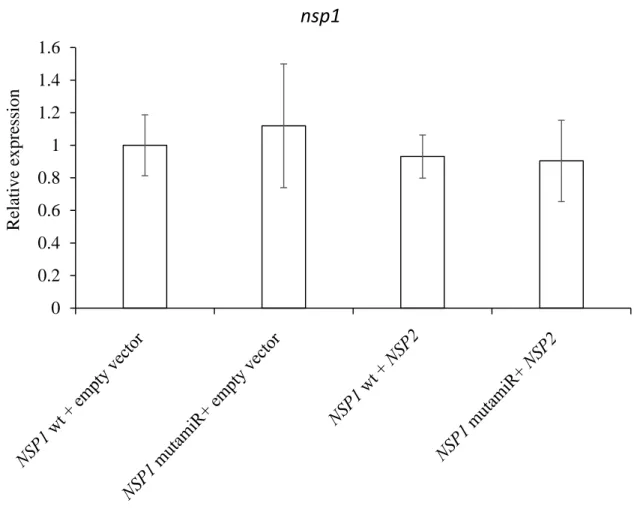
Materials and Methods
- Plant and fungal materials, growth and conditions
- Strigolactone treatment
- Mycorrhizal phenotyping and fungus staining
- Statistical analyses
Since Sl-IAA27 expression of tomato can be downregulated by exogenous auxin treatment, at least in 12-day-old seedlings (Bassa et al., 2012), the lack of Sl-IAA27 expression in the inner cortex and vascular tissue of colonized root sections may be due to an activation of auxin signaling in neighboring tissues. Here, we speculate that the auxin-mediated downregulation of Sl-IAA27 transcription in colonized root sections, by negatively regulating NSP1 expression and SL synthesis, participates in the complex process of auto-regulation of mycorrhization and perhaps also to the process of arbuscule degeneration. Further studies are needed to fully understand why and how Sl-IAA27 expression is regulated at different stages of the mycorrhizal process.
To minimize the amount of GR24 used, twelve plants were used for control and four plants per RNAi S1-IAA27 line. At this stage, NSP2 is expressed while Sl-IAA27 is not induced in the colonized root part.
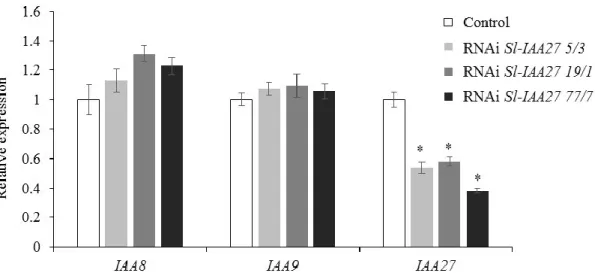
Discussion
- Roles of SLs in asymbiotic condition
- Role of SLs in the early step of mycorrhizal colonization
- Regulation of SL biosynthesis genes in colonized tissues
- Deeper insight into the role of NSP1 and NSP2 in the mycorrhizal colonization
- Role of SLs in the formation of arbuscules?
- Discovery of a new mechanism of regulation of NSP2
Liu et al., in 2011 showed that the α-symbiotic expression of D27 and MAX1 was also largely dependent on NSP2. The structural reorganization in the not yet colonized cells in the environment of the fungus was already described by Genre et al., 2008, and NSP1 could be one of these early induced factors (by Myc-LCOs?). In any case, it remains to be known why SL biosynthesis genes are expressed in the colonized cells and what their roles would be.
111 may be to influence auxin diffusion in the colonized cells via PIN relocalization (Koltai et al., 2010a; Ruyter-Spira et al., 2011). Indeed, the Nod factor-mediated induction of NSP2 is impaired in the CK-insensitive mutant cre1 ( Heckmann et al., 2011 ; Ariel et al., 2012 ).
Conclusion
Phosphate regulation of arbuscular mycorrhizal symbiosis in pea involves early and systemic signaling events. Sl-IAA27 gene expression is induced during arbuscular mycorrhizal symbiosis in tomato and Medicago truncatula. A phosphate transporter from Medicago truncatula involved in the acquisition of phosphate released by arbuscular mycorrhizal fungi.
Root colonization by arbuscular mycorrhizal fungi is influenced by plant salicylic acid content. Medicago truncatula mtpt4 mutants reveal a role for nitrogen in the regulation of arbuscule degeneration in arbuscular mycorrhizal symbiosis. Non-redundant regulation of rice arbuscular mycorrhizal symbiosis by two members of the PHOSPHATE TRANSPORTER1 gene family.
EXO70I is required for development of a subdomain of the periarbuscular membrane during arbuscular mycorrhizal symbiosis.
